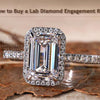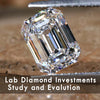
Diamond Cut and Its Types
Introduction
Are you looking to buy some diamond jewelry? Maybe an engagement ring for your beloved? In that case, you need to have a trustworthy guide at your side to help you make all the right choices. Look no further. Diamondrensu is the perfect one for this job. With expertise in all things jewelry, you can go ahead and surprise your loved ones with the best jewelry gifts ever. We know very well that shopping for diamonds with little to no knowledge about it and a loved one to impress is no joke. Going in blind for this task is never recommended.
When you start your hunt for attractive diamond or moissanite jewelry, there are various elements that you should be familiar with. You will come across terms such as diamond cut, shape, carat, color, setting, and so many other words that make no sense to you. We are here to give you a hand in such instances, especially regarding diamond cuts. So, please read the entire article to understand what is meant by the cut of a diamond and how it impacts the piece you pick.
What is a Diamond Cut?
Before getting started on all the cuts you can get, let's understand what a diamond cut means. You know that diamonds can be cut into various shapes, and how they are cut impacts their appearance. The cut is so important that it is one of the 4Cs that are considered while grading diamonds.
So, the 'cut' describes how precisely or imperfectly the diamond is cut. Also defined as the facets of the diamond, each cut brings a different kind of brilliance, sparkle, and fire from the stone. You can even say that the cut is so crucial that many gemologists consider it the most important "C." The cut can be graded on a scale ranging from Poor, Fair, Good to Very Good and Excellent. You might not know this when you are just starting your diamond shopping, but the cut has a large role to play in deciding the price and value of a stone.
Now, you also must understand that 'cut' is also used to refer to the shape of a diamond. If you look up product descriptions for pieces of jewelry online, you will see terms like marquise diamond or radiant cut diamond. This refers to the gem's shape, and shape and cut are now used interchangeably.
What Diamond Cut Sparkles the Most?
Since you are trying to make a great purchase, you need to understand what makes gemstones sparkle the way they do. The crystal structure of the stone has a role to play, but the facets or the cut of the stone also have a huge part in giving off radiant flashes when the light hits. The facets made by the cut of the stone make way for the bouncing of light, like the reflection from the surface of a mirror. Depending on the cut, the facet might be small or large, which lets light split into various colors, like a prism. The more facets the stone has, the more sparkle you will see. Certain cuts are done just to increase the brilliance of the stone.
When it comes to the cut that sparkles the most, it has to be the round cut. With 57 or 58 facets, if you include the one on the bezel, this diamond cut boosts brilliance like no other. From its inception, the standard round cut was done to give a stone the brightest fire possible. Engineered in the 1900s, the facets of the round brilliant cut give you complex yet gorgeous results. The light reflecting off the numerous surfaces of the round cut stone gives you a magical sparkle that is the brightest you will find on earth.
Why is the Diamond Cut Essential for Sparkle and Reflection?
To understand the role of a diamond's cut in sparkle and reflection, you need to have a quick science lesson. Let's get into it without further ado.
When a jeweler cuts a diamond, the light from the environment enters the stone from the top surface. The light bounces from facet to facet and finds an exit through the crown of the stone. Light bouncing in this manner creates the breathtaking radiance that diamonds are known for.
A set of phenomena that works behind the radiance of diamonds include:
- Brilliance is the intensity of the light that comes out at the crown of the diamond in the end. This is the foundation for a diamond's beauty, which is why you will find the term in most product descriptions. Your local jeweler might start describing a diamond with its brilliance.
- Dispersion is another term that impacts the sparkle of your diamond. It is also described as fire in some cases. Scientifically speaking, this is the white light that has been refracted inside the diamond and then emerges out of the stone in the colors of the visible spectrum.
- Scintillation is, strictly speaking, the sparkle of the diamond. A diamond with well-cut facets reflects small bursts of light every time it moves or the light outside moves. When you see your diamond sparkle from a distance, you can thank scintillation for this.
You need to understand that the quality of the cut is integral to how these phenomena produce desirable results. This is why the cut of the diamond is vital in deciding the stone's appearance, and you need to keep an eye on the grade of the cut before making a purchase.
What are the Types of Diamond Cuts?
Radiant Cut
As mentioned, if you want the most sparkle without looking for much, the standard round radiant cut diamond is your pick. Whether it is an engagement ring or a tennis bracelet that the stone is set into, you can obtain mesmerizing results effortlessly. Accounting for more than two-thirds of the diamonds sold around the world, this cut is not popular for no reason.
Emerald Cut
If you need a cut that is slightly different from the regular round one, the next best one is the emerald cut. This cut features stepped facets on a rectangular stone, looking for steps or layered edges on the side of the stone. If you want your diamond to look bigger than its weight, then this is the cut you need to go for.
Princess Cut
Another popular shape that comes right after the round cut is the princess cut diamond one of the newer types. With an inverted pyramid-like shape with beveled or slightly blunt edges on a rectangular or square base, diamonds have more surface area in this cut. Interestingly, the princess cut diamond has 58 facets, like the round radiant cut diamond.
Oval Cut
If you are looking for a unique stone that has rounded edges without any sharp edges, this is the cut to go for. Just like the emerald shape, oval diamonds also look larger than their actual weight. Compared to the round cut, the oval cut also gives you about 10% more surface area.
Asscher Cut
The easiest way to describe this cut is as a square emerald cut. Like the emerald, this cut, too, has large steps and a high crown. The slightly blunt corners of the cut also make the stone look like an octagon. The brilliance from the Asscher cut is somewhat similar to what you can see in a long hall of mirrors.
Marquise Cut
Occasionally described as the navette cut, the marquise diamond has existed since the Middle Ages. The Marquise diamond cut is a cross between an oval and a round cut. It is an oval diamond with slightly pointed extremes but with the facets like a round brilliant stone. This cut is ideal for giving the wearer's finger a leaner look.
Cushion Cut
The cushion cut diamond is a no-brainer for all vintage jewelry lovers. Looking like a puffy pillow-like diamond, the cushion cut diamond is a square or rectangular stone with smooth curved edges. They can hold more color than any other diamond cut out there, so going for an H-color cushion cut diamond or above is recommended.
Pear Cut
If you are on the lookout for unique shapes, consider the pear-cut diamond. Since they are difficult to cut, you might not find them as frequently as the other types. However, they can be exactly what you need to spruce up a solitaire engagement ring. With a cathedral setting or three-stone setting, the pear-cut diamond looks sophisticated.
Conclusion
Buying diamond jewelry for the first time might not go as easily as you think. With multiple factors like design, stone quality, budget, and much more to consider, you need to know what you are looking at while shopping. Even understanding the 4Cs of a diamond can go a long way.
For everything else, Diamondrensu can be your solution. Hurry up and simplify your diamond shopping with us!
Leave a comment
Please note, comments must be approved before they are published.


































